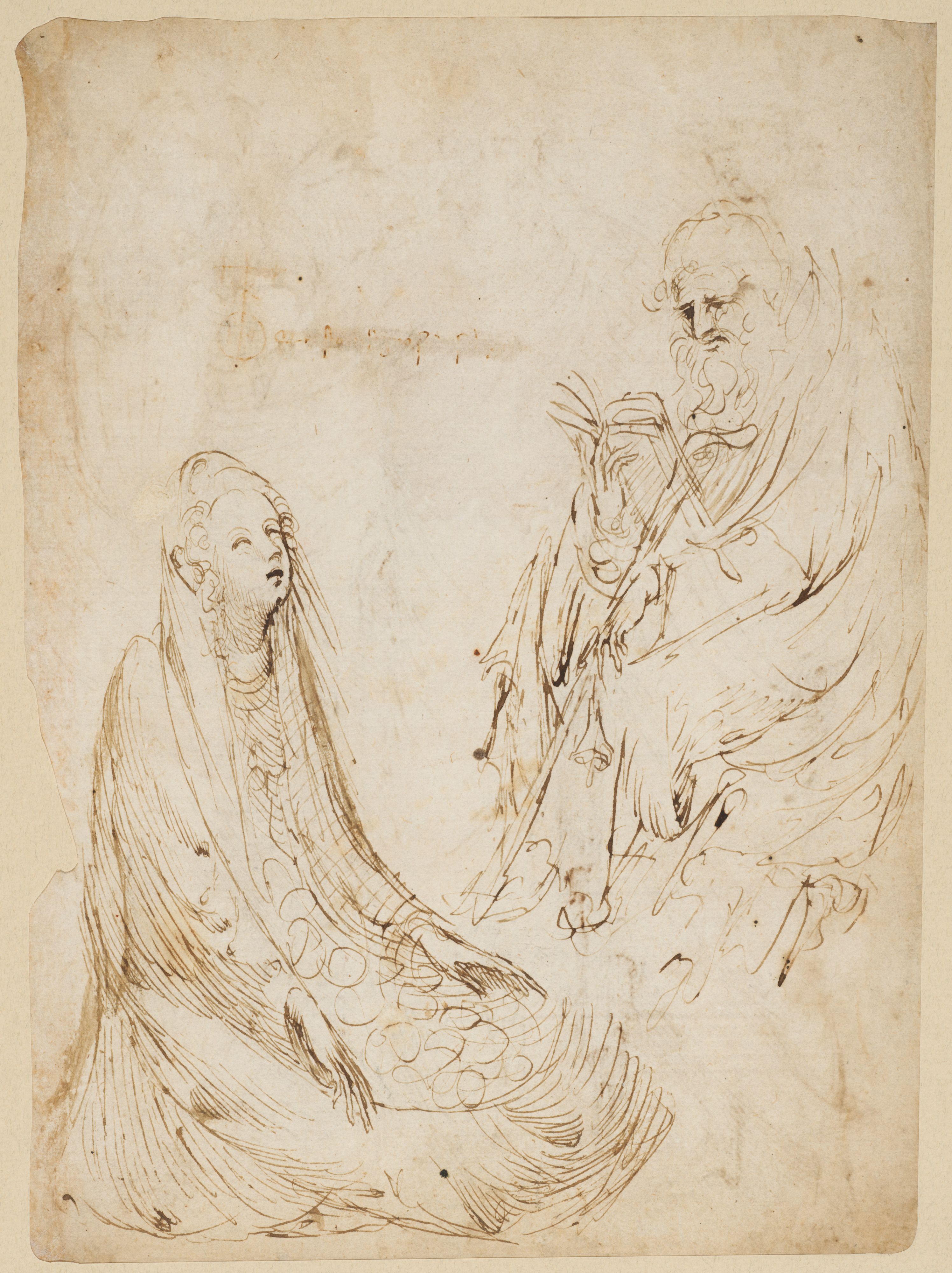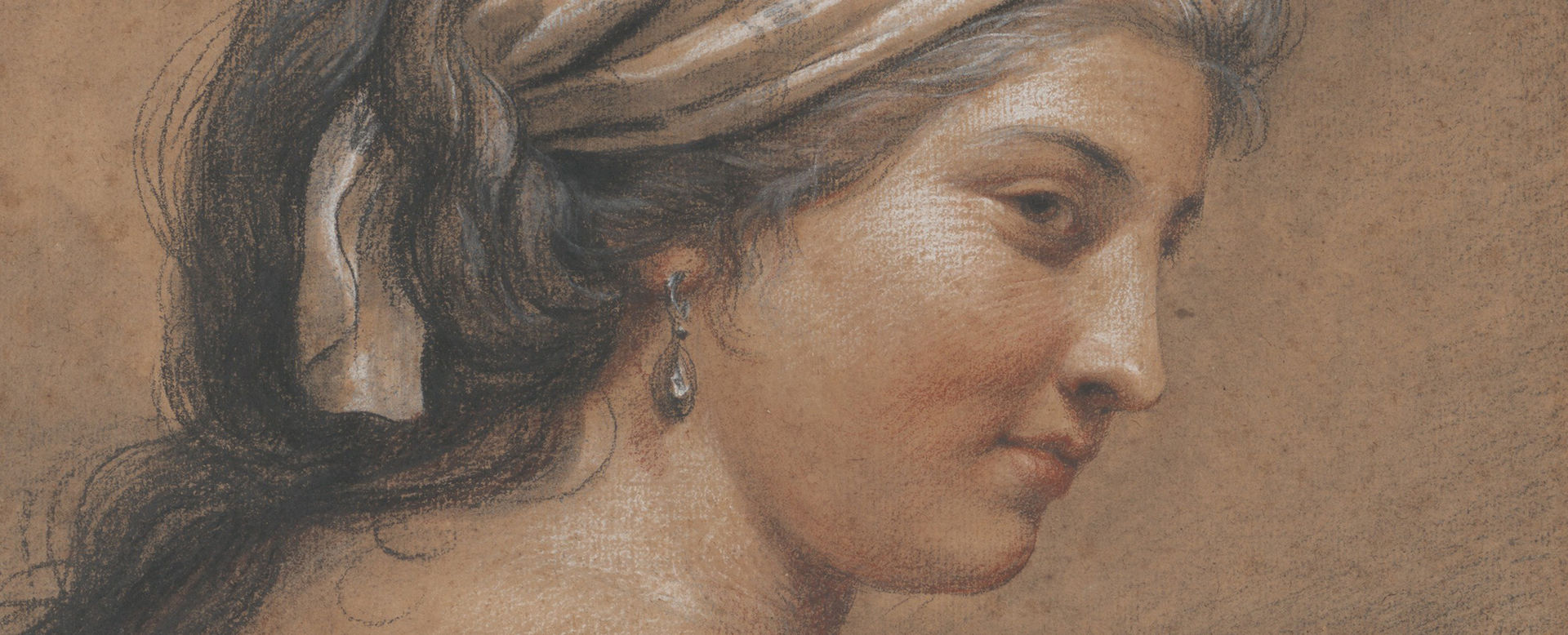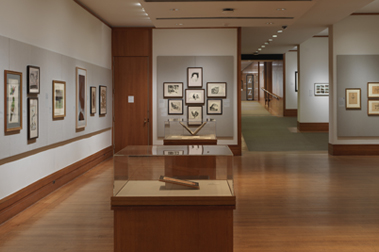Three Standing Figures (recto); Seated Woman and a Male Hermit in Half-length (verso)
Stefano da Verona (Stefano di Giovanni d'Arbosio di Francia) Italian
Not on view
The three standing figures on the recto of this sheet probably served as studies for an 'Annunciation,' according to a style of iconography that was characteristic in the stone sculptures of portals in French Gothic Cathedrals. The most famous example are the pairs of freestanding sculptures of the 'Annunciation and Visitation' of ca. 1245-55 at Reims Cathedral (right jamb of the central portal in the west façade). In fact, the volumetric modeling of the forms and the relative isolation of each standing figure on the sheet seems to confirm they were studied from sculptures in the round. At center and left is the same figure of a youth but portrayed from two different points of view, front and back, and these studies were probably intended for the annunciating Angel Gabriel, although he is not winged and the position of the arm has been changed. At right, the figure of the Annunciate Virgin reads a book, her traditional attribute. On the verso, the seated female figure may have been preparatory for a saint or a 'Madonna of Humility ' (the Virgin always sits on the ground in this iconography).
The old bearded man at right, dressed in rags and holding an open book in his right hand and in his left a staff with a Tau-shaped handle and a bell, was preparatory for the hermit saint, Antony Abbot (or St. Antony the Great). It is possible that the seated beautiful woman at left on the verso was intended for a depiction of St. Elizabeth of Hungary (1207-1231), who is a symbol of charity for the Franciscan order and whose traditional attribute is an apron full of loaves of bread which were transformed into roses by a miracle. This would explain the elegant cloth with cascading small, round objects adorning the woman’s torso and lap in the Metropolitan drawing.
In any case, this design for the seated woman on the verso of the sheet is also very closely evocative of Stefano’s painting of the 'Adoration of the Magi,' in the Pinacoteca di Brera, Milan (Reg. Cron. 349), and the figure in the drawing may have been repurposed to study the Virgin Mary in the painting. The drawing and the Brera painting have been reunited for the first time in their modern history for an exhibition in 2015 ('Il Primato del Disegno,' Pinacoteca di Brera, Milan 2015). The important contemporary inscription on the upper left quadrant of the verso of the Metropolitan Museum sheet, which was partly erased by scratching on the paper, reads: "Questo desegno fo de felixo." A number of sheets by Stefano da Verona and his workshop have inscriptions with this or similar wording, which was added by an early Veronese collector (catalogued by Frits Lugt as no. 2990). Evelyn Karet identified the name "felixo" in the inscription as that of the great Veronese humanist Felice Feliciano, who seems to have assembled an important art collection, but this remains a hypothesis.
Still a very early example of a creative drawing on paper, this sheet is one of a small handful of extant drawings by Stefano da Verona, which was discovered in 1996. It is a page from a sketchbook or modelbook by the artist which also included two other double-sided sheets in Florence and Dresden with drawings that had been well known in the literature. The recto of the Florence sheet depicts three similar standing female figures (Gabinetto Disegni e Stampe degli Uffizi inv. 1106 E), while the Dresden recto presents two standing female figures with the motif of a nude female bust at left (Kupferstichkabinett inv C125). The verso of the Dresden sheet portrays at right a grouping of a youth and a female figure in a very similar design to the recto of the Metropolitan Museum sheet, hence must have been conceived with a similar project in mind.
All three sheets from New York, Florence, and Dresden are done in the same technique with a quill pen and iron gall ink, and are on the same distinctive type of paper (which exhibits laid lines but almost no visible chain lines). The sheets have also similar dimensions. A concentrated drop of iron gall ink caused a loss of the paper (along the left border of the verso): a similar loss from concentrated iron gall ink appears on the border of the Dresden sheet and a damaging stain occurs in the same area in the Uffizi sheet further confirming that all three sheets were part of the same quire of paper in which the ink pooled into the gutter causing the portion of damage. Moreover, the Dresden sheet exhibits a watermark that dates the paper to Verona ca. 1418 (near Briquet 4005; Melli 2006, p. 36).
The elegant elongated figures, together with the expressive drawing technique of very long flowing outlines and spidery, expressive parallel-hatching and cross-hatching in the shadows, are all typical of Stefano da Verona. Stefano probably trained in the tradition of the French Gothic style by his father, Jean d’Arbois (died 1396), court painter to Philip the Bold, Duke of Burgundy, at Dijon. Jean d’Arbois was himself in Pavia in 1385 and 1392, called "Giovanni Herbosio" in documents.
The French Gothic elements are manifest in the attenuated proportions of the figures, the elegant cadences of their draperies, and the gentle sway of the "s" curve in the standing figures depicted in the three sheets. The expressive hatching and nets of reinforcement outlines in the Metropolitan Museum sheet produce a startlingly modern effect. The inscriptions on the painting "Stefanus pinxit" and date at lower right "143[5]" (the last cipher is a modern addition) have been sometimes doubted in the literature, but technical examination seems to indicate that they are original, as described by Esther Moench Scherer (in 'Pinacoteca di Brera: scuola veneta', Milan 1990, pp. 366-70). The Brera 'Adoration' provides the stylistic basis for dating also the drawings in New York, Florence, and Dresden (see Carmen C. Bambach in 'Il Primato del Disegno', exh. cat. Pinacoteca di Brera, Milan 2015).
(Carmen C. Bambach, 2015)
This image cannot be enlarged, viewed at full screen, or downloaded.
This artwork is meant to be viewed from right to left. Scroll left to view more.








